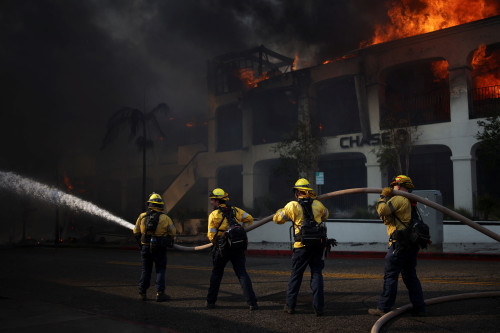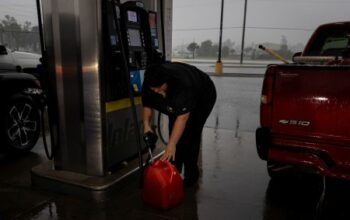By Alison Withers and David Stanway
(Reuters) – Scientists said the wind-whipped wildfires tearing across the arid Los Angeles landscape mark the latest in climate-fuelled weather extremes that are likely to escalate further as global temperatures continue to climb.
Erupting well outside of the traditional wildfire season, the California blazes were spreading quickly on Wednesday.
For California, scientists now consider fire to be a yearlong risk. The western U.S. state has also seen increasingly massive conflagrations in recent years, with more acreage burned amid drying conditions and shifting weather trends.
“Climate change is reshaping the regimes – the characteristic patterns of wildfire in a region,” said Kimberley Simpson at the School of Biosciences at the University of Sheffield.
Within hours of weather alerts warning of extreme winds and dry conditions in the L.A. area Tuesday night, parts of the iconic desert city were ablaze.
Sparks jumped highways and set rooftops alight. Palm trees flared up like matchsticks against the night sky. By Wednesday morning, tens of thousands of people were fleeing their homes as the fires burned out of control.
WIND FACTORS
Los Angeles, spanning a corner of the Southern California desert, is no stranger to wild winds and warm, dry weather, with its famed Santa Ana winds blowing regularly across the landscape toward the coast. Amid dry winter conditions, it is not uncommon for rapid winds to develop, said Brent Walker with Britain’s Met Office.
However, the atmospheric event fuelling the L.A. fires isn’t a typical Santa Ana downslope event. Instead, anomalously strong winds are blowing off the back of a strangely shaped storm system over the lower Colorado River Valley and being amplified by what scientists call a “mountain wave” event.
A mountain wave phenomenon occurs when there are certain temperatures above a mountain range and particular winds passing over those mountains.
“When those conditions line up perfectly, it does behave just like a wave in the ocean, when the winds flow over the mountains and then come crashing down on the other side,” said scientist Paul Schlatter with the National Weather Service in Boulder, Colorado.
“Just the strength of those (storm system) winds and a little bit of the mountain wave enhancement is really what’s fuelling those fires,” Schlatter said.
A similar mountain wave occurred around Colorado’s fast-moving Marshall Fire on Dec. 30, 2021, which was fanned by downslope winds gusting at up to 115 mph and wiped out thousands of homes and businesses before being snuffed out by snowfall the following night. “Any fire under those conditions is going to go quickly out of control,” Schlatter said.
This week’s snowstorms over the San Bernardino Mountains, roughly a two-hour drive from Los Angeles, could also be contributing to the regional wind dynamics.
Meanwhile, area forecasters expect a Santa Ana wind event later this week.
FUEL MATTERS
Ahead of the fires, the U.S. National Weather Service issued several alerts for the heavily populated region – warning of the fire risk and “critically dry fuels,” meaning the arid landscape of shrubs, palms, grasses and hardwoods was ready to burn.
As California’s average temperature has warmed by roughly 1 degree Celsius (2.5 degrees Fahrenheit) since 1980, the number of days with dry vegetation – vulnerable to fire – has doubled, said fire management expert Lindon Pronto at the European Forest Institute.
“Eventually you have a compounding effect where you see much more extreme fire behaviour at different times of the year … whether it’s in December or January,” he said.
Beyond the chaparral and eucalyptus trees, Los Angeles’ densely populated urban landscape also includes flammable material with hanging power cables, wooden telephone poles and homes built with wood in accordance with earthquake codes.
Wood construction was also a major factor in the rapid spread of the 2023 fire in Hawaii’s historic city of Lahaina and the massive destruction in its wake.
Scientists warned of other hazards amid the fire, including the risk of rockslides from steep slopes after vegetation burns away, or exploding propane tanks, gas lines or other hazardous material as fire moves into people’s storage spaces and industrial areas.
“There’s, there’s a massive amount of just hazardous material in all of these homes which are on fire,” Pronto said.
(Reporting by Ali Withers and David Stanway. Writing by Katy Daigle and Aurora Ellis)







